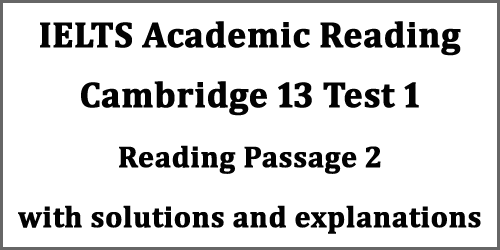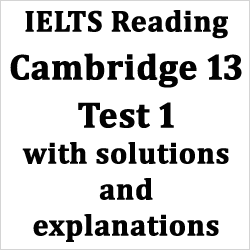IELTS Reading: Cambridge 13 Test 1 Reading Passage 2, Why being bored is stimulating and useful, too; with best solutions, explanations and bonus tips
This IELTS Reading post is the second of the series post deals with a total solution package for IELTS Cambridge 13 Reading test 1. In this post, I’ve discussed all the answers and solutions for Reading Passage 2 which is entitled ‘Why being bored is stimulating – and useful, too’. This is a targeted post for candidates who have major difficulties in finding and understanding Reading Answers. This post can direct you the best to comprehend every Reading answer with no trouble and without much trouble. Finding IELTS Reading answers is a step-by-step process and I hope this post can help you in this case.

Reading Passage 2:
The headline of the passage: Why being bored is stimulating – and useful, too
Questions 14-19: (List of headings)
Follow the same rules of finding answers for the List of Headings and check the first and last few lines of each paragraph. Most of the time, the answer is there for you containing some synonymous words, which match with the lists of headings. If you cannot find the answers in the first and last few lines, you may need to check the middle of the paragraphs. (This we did in other tests too.)
Question 14: Paragraph A
For this question, check line 3 of Paragraph A. The line says, “But defining boredom so that it can be studied in the lab has proved difficult.”
Let’s analyse the sentence here. The phrase ‘has proved difficult’ in the sentence means that there is a problem with the science to define boredom.
So, the answer is: iv (Problems with a scientific approach to boredom)
Question 15: Paragraph B
The answer is in lines 1-3 of the paragraph. Here, the writer says, “By asking people about their experiences of boredom, Thomas Goetz and his team at the University of Konstanz in Germany have recently identified five distinct types: indifferent, calibrating, searching, reactant and apathetic. These can be plotted … … .”
So, we can gather from these lines that there is an explanation of how a team of scientists has classified the feelings of boredom.
So, the answer is: vi (Creating a system of classification for feelings of boredom)
Question 16: Paragraph C
In lines 2 and 3 of Paragraph C, we can find a sentence about the finding of psychologist Sandi Mann of the University of Central Lancashire. “Mann has found that being bored makes us more creative.” This means that boredom can result in something good (productive outcomes).
So, the answer is: i (The productive outcomes that may result from boredom)
Question 17: Paragraph D
We can get the answer having a quick look in lines 6-7 of paragraph D. The lines say, “… . .. But even if boredom has evolved to help us survive, it can still be toxic if allowed to fester.” The word ‘toxic’ here means poisonous or extremely bad or dangerous.
So, the answer is: v (A potential danger arising from boredom)
Question 18: Paragraph E
We can get an idea of what paragraph E talks about by reading the first 2-3 lines. Here the writer says, “Eastwood’s team is now trying to explore why the ‘attention system’ fails. It’s early days but they think that at least some of it comes down to personality. Boredom proneness has been linked with a variety of traits.” From these lines, we can gather that the researchers or scientists are working on the identification of people who are most prone to or most affected by boredom.
So, the answer is: viii (Identifying those most affected by boredom)
Question 19: Paragraph F
The first and second lines of paragraph F talk about a new theory about boredom – “…. that our over-connected lifestyles might even be a new source of boredom.” Then, in lines 4-5, the writer provides a possible treatment for this new source of boredom – “…. So instead of seeking yet more mental stimulation, perhaps we should leave our phones alone, and use boredom to motivate us to engage with the world in a more meaningful way . .. …”.
So, the answer is: iii (A new explanation and a new cure for boredom)
Question 20-23: (Matching names of people with their ideas or statements)
(The rules for finding answers to this sort of question are simple. Just find the name of the person and read around it carefully. Then, give a quick look to check whether there is another statement or idea provided by the same person in the text. If there is, check the reference carefully and decide your answer. Remember, the questions may not follow any sequential order. )
Question 20: Peter Toohey
In paragraph A, we find an idea shared by Peter Toohey. Look at the last lines – “If disgust protects humans from infection, boredom may protect them, from ‘infectious’ social situations .. . ..” It means boredom may help us to avoid an unpleasant situation. Here, infectious means displeasing/unpleasant.
So, the answer is: E (Boredom may encourage us to avoid an unpleasant experience)
Question 21: Thomas Goetz
There are two references for Thomas Goetz in this passage – in paragraphs B & E. So, we need to look at paragraph B first. In the first few lines, we can see that Goetz and his team have identified five types of boredom and when you read further, in lines 7-8, the writer states, “Of the five types, the most damaging is ‘reactant’ boredom with its explosive combination of high arousal and negative emotion.”
So, the answer is: B (One sort of boredom is worse than all the others)
Question 22: John Eastwood
Again, there are two references to John Eastwood in paragraphs D & E. So, we need to look at paragraph D first. If we don’t find the answer there, we can have a look at paragraph E. In paragraph D, lines 7-9 say, “For Eastwood, the central feature of boredom is a failure to put our ‘attention system’ into gear. This causes an inability to focus on anything which makes time seem to go painfully slowly.” The lines indicate that if anyone tries and cannot focus on anything (attention system failure), this may give a bad feeling that the time has slowed down which may make anyone more and more irritated.
So, the answer is: D (Trying to cope with boredom can increase its negative effects)
Question 23: Francoise Wemelsfelder
There is only one reference to Wemelsfelder and that’s in Paragraph F, the very last one. Take a careful look lines 1-2, “Psychologist Francoise Wemelsfelder speculates that our over-connected lifestyles might even be a new source of boredom.” This clearly indicates that our present lifestyle may inspire boredom.
So, the answer is: A (The way we live today may encourage boredom)
Questions 24-26: (Completing summary with ONE WORD ONLY):
Question 24: For John Eastwood, the central feature of boredom is that people cannot ________, due to failure in what he calls the ‘attention system’,.. .. . . .
Keywords for this answer: central feature, people cannot
The question starts with the name of John Eastwood. So, we simply need to go to paragraph D and start looking for answers there. In line 7, we can see the phrase ‘central feature’. So, we can read this line – “For Eastwood, the central feature of boredom is a failure to put our ‘attention system’ into gear. This causes an inability to focus on anything.” Here, inability = cannot
So, the answer is: focus
Question 25: His team suggests that those for whom ______ is an important aim in life may have problems in coping with boredom, …. . . ..
Keywords for this answer: suggests, important aim in life, may have problems
In paragraph E, lines 3-4 say, “People who are motivated by pleasure seem to suffer particularly badly.”
This means people who depend on pleasure, may have problems coping with pleasure.
So, the answer is: pleasure
Question 26: …. whereas those who have the characteristic of ______ can generally cope with it.
Keywords for this answer: characteristic, generally cope with it
This answer needs some understanding. In lines 4 and 5, we see – “Other personality traits (characteristics), such as curiosity, are associated with a high boredom threshold.” Here, the word ‘threshold’ means the point where something changes or turns into something else. So, high boredom threshold means where boredom changes completely/ tendency to not get bored quickly. Thus, it further means people with curiosity can cope with boredom.
So, the answer is: curiosity
Bonus tips:
You need to be careful about spelling in the Reading module. All spelling mistakes will result in penalty and the band score will rapidly decrease. So, check your spelling.
Please, make sure you make a below if you have any queries or more explanations.
Click here for solutions to Cambridge 13 Reading Test 1 Passage 1
Click here for solutions to Cambridge 13 Reading Test 1 Passage 3
Important vocabulary with explanations for Cambridge 13 Test 1 Reading Passage 1, 2, 3




I think question no 25
“People who are mentioned” should be replaced by “people who are motivated”
Thnx, I checked and corrected the mistake.
How can be find the heading . PL put more tips and tricks on how to find it easily.
Respected sir, I have a very important question. In this paragraph, there are three types of questions such as 1. Choose the correct heading 2 match the person with ideas 3 complete the summary.
Now my question is wheather we should solve step by step all types or at a time all types…
Bro this site is very helpful for reading module. I just checked reading answer that’s why i say only reading module. 🙂 Now I’ll search other ielts modules .
Thanks a lot for your compliments.
this iv very useful. thanks
I think the phrase “high boredom threshold” can be interpreted as ” not feel bored easily”
Good
Sir we need mobile application of this website?
This is an amazing website, which I suggested to all my friends.
Sir, this website is really helpful. I need reading test guide for books 13-18. But I’m not able to find all of them. Please assist.
I want to ask all the answers of all blanks are always in order??? Please tell me. Because I often become confused about this.